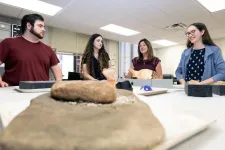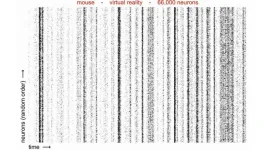(Press-News.org) Research Highlights:
A retrospective look at Get With The Guidelines® – Stroke registry data from 2003 to 2022 finds substantial and sustained improvements in acute stroke care among those in the quality improvement program.
Researchers found increased adherence to evidence-based stroke care translates to better clinical outcomes and, ultimately, more patients being discharged home or to a skilled nursing facility more quickly.
Overall, authors say the positive trends suggest concerted quality improvement initiatives can improve stroke care delivery and patient outcomes across diverse populations and locales.
DALLAS, Oct. 24, 2024 — New research published this month shows the key role quality improvement programs play in ensuring hospitals can adequately fight one of the biggest public health threats facing our country: stroke.
This new research, published in Stroke, the peer-reviewed scientific journal of the American Stroke Association, a division of the American Heart Association, shows Get With The Guidelines® - Stroke has become an integral part of stroke clinical practice and research in the U.S. Nearly 8 million stroke cases have been entered into its registry from more than 2,800 hospitals, capturing about three-quarters of stroke hospitalizations across the country.
The study finds substantial and sustained improvements in acute stroke care among those in the quality improvement program. Reviewing two decades of data, researchers found increased adherence to evidence-based stroke care translates to better clinical outcomes and, ultimately, more patients being discharged home or to a skilled nursing facility more quickly.
Due to the importance of timely intervention, the time it takes to provide patients with ischemic strokes (clotted causes strokes) thrombolytic therapy (which uses medication to dissolve clots), also known as “door-to-needle time,” is now a standard marker. In conjunction with the Association’s Target: Stroke program, door-to-needle (DTN) time of less than one hour nearly quadrupled and improvement for DTN time within 45 minutes was even greater, increasing eight-fold. Similar improvements were also observed in endovascular therapy, which uses a catheter to access blood vessels and capture and remove the clot.
“This is particularly relevant in the context of stroke care, where the goal is not only to save lives but also to restore function and maintain quality of life,” said Gregg C. Fonarow, M.D., FAHA, American Heart Association volunteer, lead author of the study, director of the Ahmanson-UCLA Cardiomyopathy Center, co-director of the Preventative Cardiology Program and Eliot Corday Chair in Cardiovascular Medicine and Science at the University of California, Los Angeles. “Stroke is an exquisitely time-sensitive disease and Get With The Guidelines promotes delivery of evidence-based acute stroke care in a timely fashion, which in turn improves patient-centered clinical outcomes.”
Overall, the positive trends suggest concerted quality improvement initiatives can improve stroke care delivery and patient outcomes across diverse populations and locales, the authors say.
Stroke remains the No. 5 cause of death and the leading cause of long-term disability in the United States. When a stroke happens, early detection and treatment are key to improving survival, minimizing disability and accelerating recovery times. Yet, in the early 2000s, there was wide variability in management of stroke, and many patients did not receive recommended interventions. The American Heart Association, celebrating 100 years of lifesaving service as a global force for healthier lives for all, set out to change that.
In 2003, the Association launched Get With The Guidelines - Stroke, a hospital registry program designed to ensure patient care is aligned with the latest research- and evidence-based guidelines. Early results demonstrated that Get With The Guidelines implementation was associated with improvements in acute stroke care and secondary prevention.
Since the launch of the stroke program, Get With The Guidelines quality improvement modules have been added to cover atrial fibrillation, coronary artery disease, heart failure and resuscitation. Each program promotes consistent adherence to the latest research-driven guidelines and measurement, while providing data and information to professionals for continual improvement in patient care. All Get With The Guidelines modules are associated with significant improvements in multiple processes of care strongly linked to improved outcomes.
Study details, background and design:
This registry-based retrospective observational cohort of all stroke and TIA admissions from hospitals participating in the Get With The Guidelines – Stroke program between April 2003 and December 2022.
Their median age was 71; 51% were self-identified as female.
The analysis examined patient characteristics, adherence to performance measures and in-hospital outcomes in patients hospitalized for acute ischemic stroke, subarachnoid hemorrhage, intracerebral hemorrhage and transient ischemic attack. Researchers quantified temporal changes in performance measure adherence and clinical outcomes over time.
Co-authors, disclosures and funding sources are listed in the manuscript.
Studies published in the American Heart Association’s scientific journals are peer-reviewed. The statements and conclusions in each manuscript are solely those of the study authors and do not necessarily reflect the Association’s policy or position. The Association makes no representation or guarantee as to their accuracy or reliability. The Association receives funding primarily from individuals; foundations and corporations (including pharmaceutical, device manufacturers and other companies) also make donations and fund specific Association programs and events. The Association has strict policies to prevent these relationships from influencing the science content. Revenues from pharmaceutical and biotech companies, device manufacturers and health insurance providers and the Association’s overall financial information are available here.
Additional Resources:
Multimedia is available on the right column of release link.
Stroke review article (May 2024): Twenty Years of Get With The Guidelines-Stroke: Celebrating Past Successes, Lessons Learned, and Future Challenges | Stroke (ahajournals.org)
###
About the American Heart Association
The American Heart Association is a relentless force for a world of longer, healthier lives. We are dedicated to ensuring equitable health in all communities. Through collaboration with numerous organizations, and powered by millions of volunteers, we fund innovative research, advocate for the public’s health and share lifesaving resources. The Dallas-based organization has been a leading source of health information for a century. During 2024 - our Centennial year - we celebrate our rich 100-year history and accomplishments. As we forge ahead into our second century of bold discovery and impact our vision is to advance health and hope for everyone, everywhere. Connect with us on heart.org, Facebook, X or by calling 1-800-AHA-USA1.
END
Study offers ‘compelling evidence’ for continuous stroke care improvement
After 20 years of American Heart Association’s Get With The Guidelines data, research finds substantial, sustained improvements in acute stroke treatment
2024-10-24
ELSE PRESS RELEASES FROM THIS DATE:
Professor awarded NEH grant to advance anthropology research collections at Texas A&M
2024-10-24
Dr. Katie Custer Bojakowski, an instructional assistant professor in the Department of Anthropology at Texas A&M University and the director and curator of its Anthropology Research Collections (ARC), has been awarded a Preservation Assistance Grant from the National Endowment for the Humanities (NEH).
The NEH’s Preservation Assistance Grants program helps organizations protect their collections of historical and cultural items, making sure they remain available for students, scholars and the public. These grants help address risks to these collections, ...
New tool helps scientists spot patterns in mountains of data
2024-10-24
Neuroscientists have learned a lot – like which neurons and circuits are associated with different behaviors – by recording the activity of small sets of neurons.
But what happens when you record thousands of neurons at one time? Or when you want to figure out the role of neurons when there isn’t an obvious external catalyst or you’re not sure what you’re even looking for?
That’s where Rastermap comes in.
The new visualization tool developed by the Stringer and Pachitariu labs at HHMI's Janelia Research Campus helps ...
Glomerular filtration rate changes following UTI in children with vesicoureteral reflux
2024-10-24
About The Study: This cohort study uses data from the Children With Vesicoureteral Reflux trial to assess estimated glomerular filtration rate (eGFR) changes in participants with vs without recurrent urinary tract infections.
Corresponding Author: To contact the corresponding author, David S. Hains, MD, MBA, email dhains@iu.edu.
To access the embargoed study: Visit our For The Media website at this link https://media.jamanetwork.com/
(doi:10.1001/jamapediatrics.2024.4546)
Editor’s Note: Please see the article for additional information, including other authors, author contributions ...
Dandelion-shaped supernova and zombie star
2024-10-24
In 1181, a new star shone near the Cassiopeia constellation for six months before disappearing. This event, recorded as a “guest star” by Chinese and Japanese observers almost a millennium ago, has puzzled astronomers for centuries. It is one of a few supernovae to be documented before the invention of telescopes. In addition, it remained an “orphan” the longest, meaning that none of the celestial objects visible today could be assigned to it. Now known as the supernova SN 1181, its remnant has only been traced in 2021 to the nebula ...
Experts call for clear and concise regulation of exosome-based treatments
2024-10-24
Clinics that offer exosome therapies claim they have the ability to repair and regenerate tissues and treat inflammatory and other immune-related conditions in a noninvasive way. Now, a team of bioethicists and legal scholars from Japan is sounding the alarm on the urgent need for stronger regulations surrounding these unproven interventions. Their letter appears October 24 in the journal Stem Cell Reports.
“Administering these treatments to patients without scientific evidence or a clear ...
Zebrahub: New atlas tracks zebrafish development like never before
2024-10-24
When early cartographers undertook perilous expeditions to map unknown corners of the world with sextants, compasses, and hand-drawn diagrams, it’s unlikely they imagined that someday anyone with an internet connection would have access to a seamless view of the entire planet from the comfort of their own home. Today, pioneering scientists are working to create a similar experience for a much tinier, but no less important domain: developing embryos. The goal is to track and map the behavior of each and every cell working together to create an adult lifeform, and present that map in a clickable, ...
Unnoticeable electric currents could reduce skin infections
2024-10-24
Using a few zaps of electricity to the skin, researchers can stop bacterial infections without using any drugs. For the first time, researchers designed a skin patch that uses imperceptible electric currents to control microbes. The results appear October 24 in the Cell Press journal Device.
“This opens up exciting possibilities for drug-free treatments, especially for skin infections and wound healing, where antibiotic-resistant bacteria pose a serious challenge,” says University of Chicago’s Bozhi Tian, one of the paper’s ...
Expanded newborn screening using genome sequencing for early actionable conditions
2024-10-24
About The Study: These interim findings demonstrate the feasibility of targeted interpretation of a predefined set of genes from genome sequencing in a population of different racial and ethnic groups. DNA sequencing offers an additional method to improve screening for conditions already included in newborn screening and to add those that cannot be readily screened because there is no biomarker currently detectable in dried blood spots. Additional studies are required to understand if these findings are generalizable to populations of different racial and ethnic groups and ...
In pioneering study, gene technology outperforms standard newborn screening tests
2024-10-24
Early results from a study of newborn screening methods show that DNA analysis picks up many more preventable or treatable serious health conditions than standard newborn screening and is favored by most parents who are offered the option.
The study—called GUARDIAN—is one of the first large-scale studies in the world to use genome sequencing as a method for newborn screening and is the first to publish preliminary results.
“The results show us that genome sequencing can radically improve children’s medical care,” says Joshua Milner, professor of Pediatrics, director of Allergy/Immunology and Rheumatology ...
Racial disparities in receipt of guideline-concordant care in older adults with early breast cancer
2024-10-24
About The Study: In this cohort study, non-Hispanic Black race was associated with increased odds of not receiving guideline-concordant care (GCC) and less timely treatment initiation. Non-Hispanic Black race was associated with increased all-cause mortality, which was reduced after adjusting for GCC and clinical and sociodemographic factors. These findings suggest that optimizing timely receipt of GCC may represent a modifiable pathway to improving inferior survival outcomes among older non-Hispanic Black ...
LAST 30 PRESS RELEASES:
House sparrows in northern Norway can help us save other endangered animals
Crohn's & Colitis Foundation survey reveals more than 1/3 of young adults with IBD face step therapy insurance barriers
Tethered UAV autonomous knotting on environmental structures for transport
Decentralized social media platforms unlock authentic consumer feedback
American Pediatric Society announces Vanderbilt University School of Medicine as host institution for APS Howland Visiting Professor Program
Scientists discover first method to safely back up quantum information
A role for orange pigments in birds and human redheads
Pathways to net-zero greenhouse gas emissions for Southeast Asia
A JBNU–KIMS collaborative study on a cost-effective alloy matches superalloys for power plants and energy infrastructure
New study overturns long-held model of how plants coordinate immune responses.
New AI model predicts disease risk while you sleep
Scientists discover molecular ‘reshuffle’ and crack an 80-year-old conundrum
How stressors during pregnancy impact the developing fetal brain
Electrons lag behind the nucleus
From fungi to brain cells: one scientist's winding path reveals how epigenomics shapes neural destiny
Schizophrenia and osteoporosis share 195 genetic loci, highlighting unexpected biological bridges between brain and bone
Schizophrenia-linked genetic variant renders key brain receptor completely unresponsive to both natural and therapeutic compounds
Innovative review reveals overlooked complexity in cellular energy sensor's dual roles in Alzheimer's disease
Autism research reframed: Why heterogeneity is the data, not the noise
Brazil's genetic treasure trove: supercentenarians reveal secrets of extreme human longevity
The (metabolic) cost of life
CFRI special issue call for papers: New Frontiers in Sustainable Finance
HKU Engineering scholar demonstrates the smallest all-printed infrared photodetectors to date
Precision empowerment for brain "eavesdropping": CAS team develops triple-electrode integrated functional electrode for simultaneous monitoring of neural signals and chemical transmitters during sleep
Single-capillary endothelial dysfunction resolved by optoacoustic mesoscopy
HKU three research projects named among ‘Top 10 Innovation & Technology News in Hong Kong 2025’ showcasing excellence in research and technology transfer
NLRSeek: A reannotation-based pipeline for mining missing NLR genes in sequenced genomes
A strand and whole genome duplication–aware collinear gene identification tool
Light storage in light cages: A revolutionary approach to on-chip quantum memories
Point spread function decoupling in computational fluorescence microscopy
[Press-News.org] Study offers ‘compelling evidence’ for continuous stroke care improvementAfter 20 years of American Heart Association’s Get With The Guidelines data, research finds substantial, sustained improvements in acute stroke treatment



